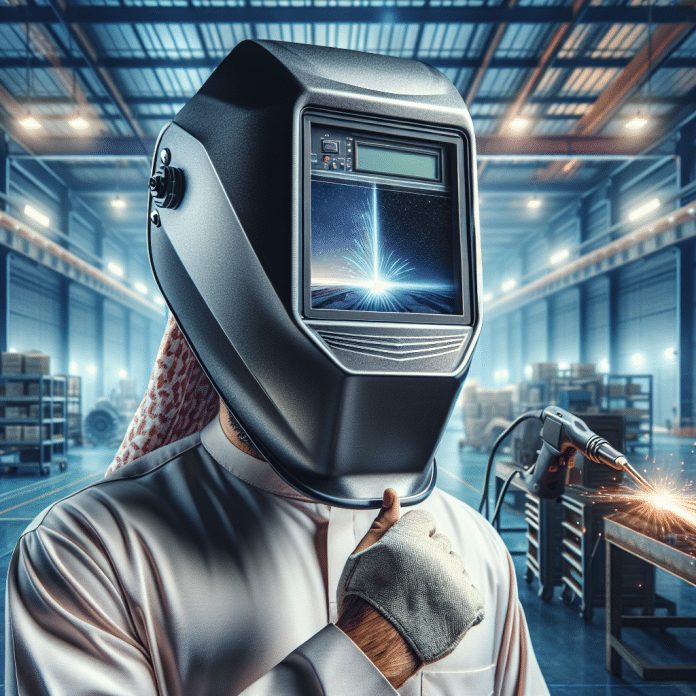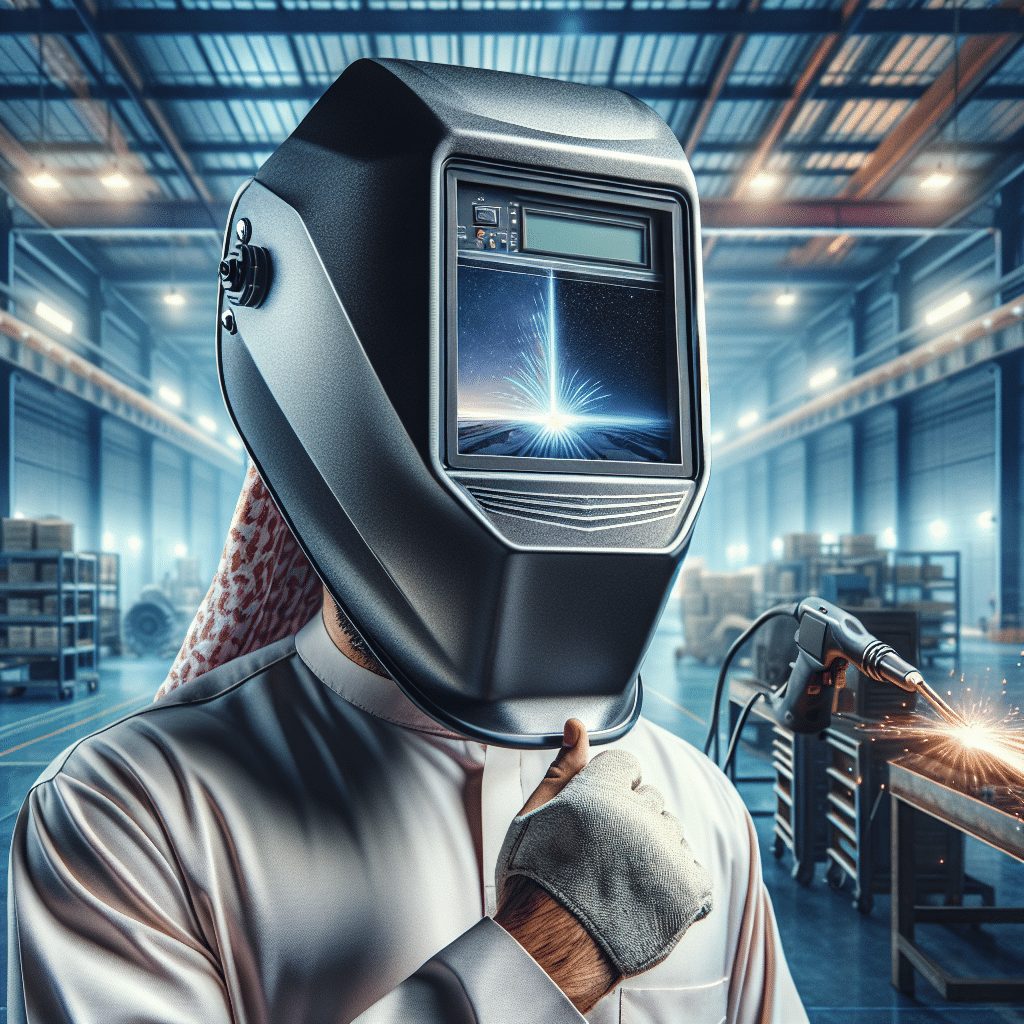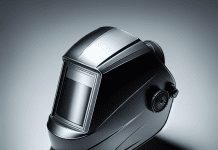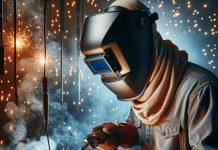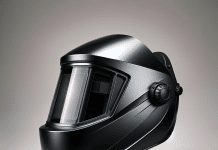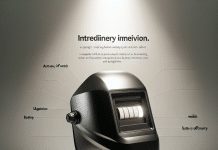Imagine being able to weld comfortably without any strain on your neck or eyes. With large viewing area welding helmets, that dream becomes a reality. These helmets are specially designed to provide a wide field of vision, allowing you to see clearly while working. Not only do they enhance your visibility, but they also offer superior protection for your face and eyes. Say goodbye to squinting and struggling to see through a tiny window. Upgrade to a large viewing area welding helmet and experience the ease and comfort of welding like never before.
Review contents
Advantages of Large Viewing Area Welding Helmets
Improved visibility
One of the main advantages of using a large viewing area welding helmet is the improved visibility it provides. With a larger field of view, you can see more of your workpiece without having to constantly readjust your helmet or move your head. This increased visibility allows for better control and precision while welding, ultimately leading to better results. Whether you’re working on a small, intricate project or a larger, more complex one, a large viewing area welding helmet can significantly enhance your overall visibility.
Reduced strain on the neck and eyes
Another benefit of using a large viewing area welding helmet is the reduced strain it puts on your neck and eyes. Traditional welding helmets with smaller viewing areas often require constant readjustment of the helmet or frequent head movements to get a clear view of the welding area. This can lead to neck strain and fatigue over time. With a large viewing area helmet, you can maintain a natural posture and reduce the strain on your neck. Additionally, the larger viewing area reduces the need to squint or strain your eyes to see clearly, reducing eye fatigue and allowing for longer, more comfortable welding sessions.
Enhanced precision and accuracy
A large viewing area welding helmet also enables enhanced precision and accuracy during welding. With a clearer and wider field of view, you can better see the details of your workpiece and make more precise welds. This is especially important when working on intricate or delicate projects that require meticulous welding. The increased visibility provided by a large viewing area helmet allows you to focus on the details and ensures that your welds are accurate, resulting in higher quality work.
Factors to Consider When Choosing a Large Viewing Area Welding Helmet
Optical clarity and high-quality lenses
When choosing a large viewing area welding helmet, it is crucial to consider the optical clarity and quality of the lenses. High-quality lenses with excellent optical clarity will ensure a clear and distortion-free view of the welding area. Look for helmets with lenses that provide true color representation and reduce the green tint commonly associated with welding helmets. Investing in a helmet with superior lenses will greatly enhance your visibility and overall welding experience.
Auto-darkening feature
An important feature to look for in a large viewing area welding helmet is the auto-darkening feature. Auto-darkening helmets utilize technology that automatically adjusts the shade of the lens in response to the welding arc. This eliminates the need to manually adjust the helmet every time you strike an arc, making the welding process more convenient and efficient. With an auto-darkening helmet, you can seamlessly transition from a clear view of your workpiece to a darkened, protected state without any interruptions.
Comfort and fit
Comfort and fit are essential factors to consider when choosing a large viewing area welding helmet. You’ll likely be wearing the helmet for extended periods, so it’s important to ensure that it is comfortable and provides a secure fit. Look for helmets with adjustable headgear and a suspension system that can be customized to your head size and shape. A well-fitting helmet will stay in place and reduce any discomfort or pressure points, allowing you to focus on your welding without distractions.
Durability and protection
A high-quality large viewing area welding helmet should be durable and capable of providing adequate protection. Welding involves exposure to various hazards, including intense heat, sparks, and flying debris. Look for helmets that are made from durable materials that can withstand the rigors of welding, such as impact-resistant polycarbonate. Additionally, check if the helmet complies with relevant safety standards to ensure that it offers sufficient protection against UV and infrared radiation.
Weight and balance
The weight and balance of a large viewing area welding helmet can significantly impact your comfort and performance. A heavy or poorly balanced helmet can cause neck strain and fatigue, making it harder to maintain an optimal welding position. Look for helmets that are lightweight yet sturdy, as they will be more comfortable to wear for extended periods. Additionally, consider the balance of the helmet and how it distributes the weight. A well-balanced helmet will feel more natural and reduce strain on your neck and shoulders.
Types of Large Viewing Area Welding Helmets
Passive welding helmets
Passive welding helmets are traditional helmets with a fixed shade lens. These helmets have a set level of darkness that cannot be adjusted. While they can offer a wide viewing area, their fixed shade lens limits visibility. Passive helmets require you to manually lift the helmet before striking an arc and then lower it back into position. While they are generally more affordable, they lack the convenience and versatility of auto-darkening helmets.
Auto-darkening welding helmets
Auto-darkening welding helmets are equipped with variable shade lenses that automatically adjust the darkness of the lens in response to the welding arc. This allows for seamless transitions between a clear view and a darkened state, without the need for manual adjustments. Auto-darkening helmets provide enhanced visibility and convenience, allowing you to maintain focus on your welding without interruptions. While they are typically more expensive, the benefits they offer in terms of comfort and productivity make them a popular choice among welders.
Passive Welding Helmets
Fixed shade lenses
Passive welding helmets use fixed shade lenses that have a constant level of darkness, usually ranging from shade 8 to shade 12. The specific shade level depends on the helmet and is determined by the lens material and coating. While this fixed shade provides consistent protection, it can limit visibility, especially when transitioning from a bright environment to the welding arc. Welders using passive helmets often have to lift the helmet to inspect their work, which can be inconvenient and interrupt the workflow.
Limited visibility
Due to their fixed shade lenses, passive welding helmets offer limited visibility compared to auto-darkening helmets. The fixed shade may not be suitable for all welding applications, especially those requiring a clearer view of the workpiece. The limited visibility can make it challenging to see intricate details or work in low-light conditions. Welders using passive helmets may need to rely on additional lighting or external magnification tools to compensate for the reduced visibility.
Manual adjustment required
With passive welding helmets, the welder must manually lift and lower the helmet to control the shading. This can be time-consuming and disruptive to the welding process. Each time the helmet is lifted, the welder’s eyes are exposed to the bright welding arc, potentially causing discomfort or temporary vision impairment. Additionally, the constant lifting and lowering of the helmet can lead to delays and reduce overall productivity.
Auto-Darkening Welding Helmets
Variable shade lenses
Auto-darkening welding helmets are equipped with variable shade lenses that adjust the level of darkness according to the intensity of the welding arc. The lenses can range from shade 3 or 4 in the clear state to shade 10, 11, or 12 in the darkened state. The ability to adjust the shading level allows for better visibility in various welding conditions, providing a clear view of the workpiece while protecting the welder’s eyes from harmful UV and infrared radiation.
Enhanced visibility
Auto-darkening welding helmets offer enhanced visibility compared to passive helmets. The ability to automatically adjust the shading level ensures that the welder has a clear and unobstructed view of the welding area, regardless of the ambient lighting conditions. This improves overall workflow and reduces the need for constant helmet adjustments or interruptions to the welding process.
Automatic adjustment
The automatic adjustment feature of auto-darkening welding helmets eliminates the need for manual control. The lenses automatically darken in response to the welding arc and return to a clear state once the arc is extinguished. This seamless transition allows the welder to focus on the welding process without having to repeatedly lift or lower the helmet. The automatic adjustment feature improves comfort and productivity, making welding tasks more efficient and enjoyable.
Safety Features to Look for in Large Viewing Area Welding Helmets
UV and infrared protection
Safety should be a top priority when selecting a large viewing area welding helmet. Look for helmets that provide adequate protection against harmful UV and infrared radiation. The lenses should have a high optical classification, indicating their ability to block a significant percentage of UV and infrared rays. Proper protection against these radiation types is essential for safeguarding your eyes and preventing long-term damage.
Heat resistance
Welding involves exposure to high temperatures, so it is crucial to choose a welding helmet that can withstand heat. Look for helmets made from heat-resistant materials that can provide reliable protection against the radiant heat generated during welding. The helmet should also have proper ventilation to prevent heat buildup and discomfort. Heat-resistant helmets will ensure your safety and comfort throughout your welding projects.
Impact resistance
In addition to heat resistance, a large viewing area welding helmet should also be impact-resistant. Welding involves potential hazards such as sparks, flying debris, and accidental impacts. A helmet with a strong, impact-resistant outer shell will protect your face and head from these potential dangers. Look for helmets that comply with relevant safety standards and have undergone rigorous impact testing to ensure their durability and effectiveness.
Sensitivity control
Some auto-darkening welding helmets offer sensitivity control settings that allow you to adjust how quickly the lens reacts to the welding arc. The sensitivity control enables you to customize the helmet’s response based on the specific welding application and environment. Being able to set the sensitivity level ensures that the lens darkens reliably when needed, without being overly sensitive or unresponsive to the welding arc.
Delay control
Delay control is another valuable feature found in certain auto-darkening welding helmets. This feature allows you to adjust the time it takes for the lens to return to the clear state after the welding arc is extinguished. Having control over the delay ensures that the lens stays dark long enough to protect your eyes from any residual brightness or sparks. It also prevents the helmet from unnecessarily darkening after the welding process is completed.
Adjustability and Comfort of Large Viewing Area Welding Helmets
Headgear and suspension system
The headgear and suspension system of a large viewing area welding helmet play a crucial role in its adjustability and comfort. Look for helmets that have adjustable straps and buckles, allowing you to customize the fit to your head size and shape. Additionally, consider the padding and cushioning in the headgear, as this contributes to the overall comfort and stability of the helmet. The headgear should securely hold the helmet in place without causing pressure points or discomfort.
Adjustable sensitivity and delay controls
Some large viewing area welding helmets offer adjustable sensitivity and delay controls. These settings allow you to fine-tune the helmet’s response to the welding arc and the time it takes for the lens to return to the clear state. Being able to customize these controls ensures that the helmet adapts to your specific welding needs and personal preferences. The ability to adjust the sensitivity and delay settings enhances both comfort and productivity during welding tasks.
Ergonomic design
The overall design of a large viewing area welding helmet should prioritize ergonomics and user comfort. Look for helmets that have a well-balanced weight distribution, minimizing strain on your neck and shoulders. The helmet should also have an ergonomic shape that fits comfortably and securely on your head. A properly designed helmet reduces fatigue and allows you to focus on your welding without distractions or discomfort.
Maintenance and Care for Large Viewing Area Welding Helmets
Cleaning the lenses
Regularly cleaning the lenses of your large viewing area welding helmet is essential for maintaining visibility and clarity. Welding generates various residues, such as spatter and slag, that can accumulate on the lenses and obstruct your view. Use a soft cloth or lens cleaning solution specifically designed for welding helmets to gently remove any debris or smudges. Avoid using abrasive materials that could scratch the lenses. Regular cleaning ensures that you have a clean and clear view of your workpiece, leading to better welding results.
Inspecting and replacing worn parts
Performing routine inspections of your large viewing area welding helmet is crucial to ensure its functionality and safety. Check the helmet for any signs of wear or damage, such as cracks in the shell or worn-out headgear. Pay particular attention to the lenses and replace them if they are scratched or damaged, as this can affect visibility and eye protection. It’s important to promptly address any worn or damaged parts to maintain optimal performance and safety.
Storing and protecting the helmet
Proper storage and protection are important for prolonging the lifespan of your large viewing area welding helmet. When not in use, store the helmet in a clean, dry place away from direct sunlight. Consider using a helmet bag or case to protect it from dust, moisture, and accidental impacts. Additionally, avoid placing heavy objects on top of the helmet, as this can cause damage. Proper storage and protection will help maintain the integrity of the helmet and ensure it is ready for use when needed.
Popular Brands and Models of Large Viewing Area Welding Helmets
Miller Digital Elite Series
The Miller Digital Elite Series is a popular choice among welders looking for large viewing area helmets. These helmets feature four independent arc sensors and a large viewing area, providing excellent visibility and accurate shade control. The Digital Elite Series helmets also offer various customizable settings, such as sensitivity and delay control, allowing welders to tailor the helmet’s performance to their specific needs. With its comfortable fit and advanced features, the Miller Digital Elite Series delivers both quality and durability.
Lincoln Electric Viking 3350
The Lincoln Electric Viking 3350 is another well-regarded large viewing area welding helmet. It offers a wide viewing area and boasts a highly responsive optical lens that automatically adjusts to the welding arc. The Viking 3350 also features a durable shell and a comfortable headgear system, allowing for extended wear without discomfort. With its reliable performance and robust construction, the Lincoln Electric Viking 3350 is a top choice for welders seeking a high-quality large viewing area helmet.
ESAB Sentinel A50
The ESAB Sentinel A50 is a technologically advanced large viewing area welding helmet that offers superior optical clarity and comfort. It features a high-definition color touchscreen control panel, allowing for easy adjustment of settings such as shade level and sensitivity. The ADF (auto-darkening filter) lens provides excellent visibility, and the ergonomic design ensures a secure and comfortable fit. The ESAB Sentinel A50 is a favorite among professional welders who prioritize performance, precision, and user-friendly features.
Conclusion
Large viewing area welding helmets offer numerous advantages, such as improved visibility, reduced strain on the neck and eyes, and enhanced precision and accuracy. When choosing a large viewing area welding helmet, consider factors such as optical clarity, the presence of an auto-darkening feature, comfort and fit, durability and protection, and weight and balance. Additionally, be aware of the different types of large viewing area welding helmets, such as passive helmets and auto-darkening helmets, each with its own benefits and limitations. Look for safety features like UV and infrared protection, heat resistance, impact resistance, sensitivity control, and delay control. Consider adjustability and comfort through features like headgear and suspension systems, adjustable sensitivity and delay controls, and ergonomic design. Proper maintenance and care, including regular lens cleaning and inspection of worn parts, will ensure the longevity and performance of your large viewing area welding helmet. Finally, familiarize yourself with popular brands and models like the Miller Digital Elite Series, Lincoln Electric Viking 3350, and ESAB Sentinel A50, known for their quality and reliability. By considering these factors and options, you can confidently choose a large viewing area welding helmet that meets your specific needs and preferences, allowing you to weld comfortably without strain.

